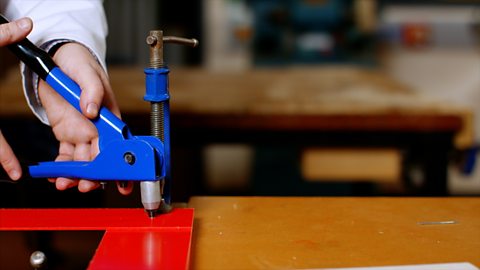Laser cutting is the use of a high-powered laser to cut, etch and engrave your material.
Before we get started here are a few things you might need:
A choice of materials for cutting
Your design
Access to a laser cutter and CAD software
Lasers cut by burning through the material and are incredibly precise.
They can be used on cardboard, paper, wood, foam, acrylic plastics as well as on some metals and glass.
It's useful to remember that it's possible to cut out and etch within the same project.
The first thing you need to do is to create your design.
Your CAD drawing has to be a vector file, which is different from an image file, as it can be resized without losing resolution and the lines remain smooth.
You can use 2D CAD programmes to make your vector file.
Lasers follow the design lines just like paths so they need to be perfectly smooth.
A CAD drawing usually consists of three colours.
The laser cutter can then be told to do different things with each colour.
The first colour should be used for the shapes that have to be cut out.
This is called 'vector cutting'.
The second colour should be used if you want to engrave sharp lines or outlines into the material.
This is called 'vector engraving'.
While it does cut into the material it doesn't cut all the way through.
The third colour is used for any designs you want to etch into the surface.
This is known as 'raster engraving' and works much like a regular laser printer.
For faster engraving, the laser cutter makes multiple passes across the surface of the material.
Once you've finalised your design, you will need to send it to the laser cutter.
There are two main variables to think about: the power of the laser and the speed it moves across the material.
The denser or thicker the material, the more power you will need to cut it.
The speed and power will also have an impact on how deep into the material the laser cuts.
With experience, you'll find which settings work best for different materials and thicknesses.
For now your teacher and the user guide for the machine will give you an idea of where to start.
So now the machine is set up, it's time to get cutting.
Laser cutters get extremely hot, so as it cuts, the machine cools the material by blowing compressed air.
Depending on the material, laser cutting can create smoke and fumes so it's important to make sure the extractor hood is turned on.
Watching the laser cutter bringing your design to life is the best bit, so enjoy it!
Laser cutters are incredibly precise, so the final product or component needs very little finishing.
Video summary
This short film explains the process of laser cutting, which is when high-powered laser is used to cut, etch or engrave a material.
Laser cutting is an increasingly common technique taught in schools. It can be used to create one-off or batch-produced components.
Teacher Notes
Points for discussion
- How can tools like laser cutters be used to easily ŌĆśscale upŌĆÖ production?
- What are the advantages of using CAM tools like laser cutters, 3D Printers and CNC lathes or milling machines for designers and manufacturers?
- How could a tool like this be used for prototyping products or components?
- Laser cutting is one of the ways to cut metals used industry. Can students think of, or research, any others?
- Why is it an advantage to use CAD/CAM in design and manufacture?
- What are the potential environmental impacts of using machines like this?
- In what ways has CAD/CAM revolutionised manufacture in recent years?
- What are the effects of CAD/CAM on the way people work?
Suggested activities
Design and make your own:
Bag tag
Bookmark
Slot together box/car/animal/festival decoration
Use laser cutting to make components for a lighting project or a piece of acrylic jewellery, or an articulated feature for amechanical toy, or an etched, personalised clock face
Use this process to create a massive range of components for your KS4 iterative design project.
Suitable for teaching design and technology (D&T) at KS3/4 in England, Wales and Northern Ireland, and 3rd and 4th level in Scotland.
Pop riveting. video
This short film explains the process of pop riveting for fixing together two pieces of a thin material such as acrylic, aluminium or polystyrene.

Block foam modelling. video
This short film explains the process of block foam modelling, which is for creating prototypes of products in the design phase.

Finishing wood. video
This short film explains the process of finishing wood to achieve a professional look.
